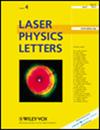Photodynamic processes for water and wastewater treatment: a review
IF 1.4
4区 物理与天体物理
Q3 OPTICS
引用次数: 0
Abstract
Photodynamic therapy (PDT) has been widely employed in clinical applications, healthcare, and public health (e.g. cancer research, microbiological control, vector control, etc). The photodynamic action is an advanced oxidation process based on the production of reactive oxygen species (ROS) and singlet oxygen by the excitation of a photosensitizer by specific wavelengths of light in the presence of molecular oxygen. The generation of ROS, which are highly reactive, encourages the use of PDT against recalcitrant pollutants and resistant parasites, a novel approach for PDT applications. Here, we explored recent research in PDT in water and wastewater treatment, elucidating operational conditions, main targets, potentials, and constraints, considering a collection of scientific papers curated by a well-defined research strategy. Retrieved records were filtered by subjects, and data was organized into a content network. Results showed that PDT is a timely alternative to deal with emerging chemical contaminants, resistant microorganisms, and other challenges, raising opportunities for versatile applications and sustainable solutions. Advances in environmental applications of PDT may help reach the Sustainable Development Goal 6 (SDG 6), but also positively impact other SDGs.用于水和废水处理的光动力工艺:综述
光动力疗法(PDT)已被广泛应用于临床应用、医疗保健和公共卫生领域(如癌症研究、微生物控制、病媒控制等)。光动力作用是一种高级氧化过程,其原理是在分子氧存在的情况下,光敏剂被特定波长的光激发,产生活性氧(ROS)和单线态氧。ROS 具有高活性,它的产生促进了光致脱氧疗法对难处理污染物和抗药性寄生虫的应用,是光致脱氧疗法应用的一种新方法。在此,我们探讨了最近在水和废水处理领域开展的光致透射法研究,阐明了操作条件、主要目标、潜力和限制因素,并考虑了根据明确的研究策略编辑的科学论文集。对检索到的记录按主题进行了过滤,并将数据组织成一个内容网络。结果表明,PDT 是应对新出现的化学污染物、抗药性微生物和其他挑战的一种及时的替代方法,为多种应用和可持续解决方案提供了机会。PDT在环境应用方面的进展可能有助于实现可持续发展目标6(SDG 6),同时也会对其他可持续发展目标产生积极影响。
本文章由计算机程序翻译,如有差异,请以英文原文为准。
求助全文
约1分钟内获得全文
求助全文
来源期刊

Laser Physics Letters
物理-仪器仪表
CiteScore
3.30
自引率
11.80%
发文量
174
审稿时长
2.4 months
期刊介绍:
Laser Physics Letters encompasses all aspects of laser physics sciences including, inter alia, spectroscopy, quantum electronics, quantum optics, quantum electrodynamics, nonlinear optics, atom optics, quantum computation, quantum information processing and storage, fiber optics and their applications in chemistry, biology, engineering and medicine.
The full list of subject areas covered is as follows:
-physics of lasers-
fibre optics and fibre lasers-
quantum optics and quantum information science-
ultrafast optics and strong-field physics-
nonlinear optics-
physics of cold trapped atoms-
laser methods in chemistry, biology, medicine and ecology-
laser spectroscopy-
novel laser materials and lasers-
optics of nanomaterials-
interaction of laser radiation with matter-
laser interaction with solids-
photonics
 求助内容:
求助内容: 应助结果提醒方式:
应助结果提醒方式:


